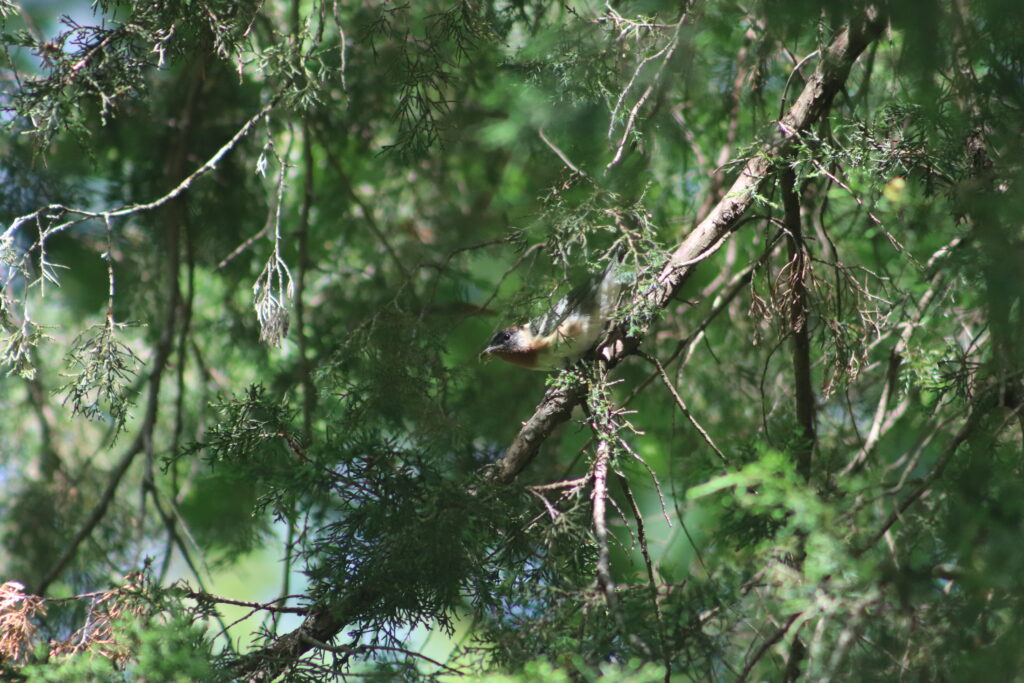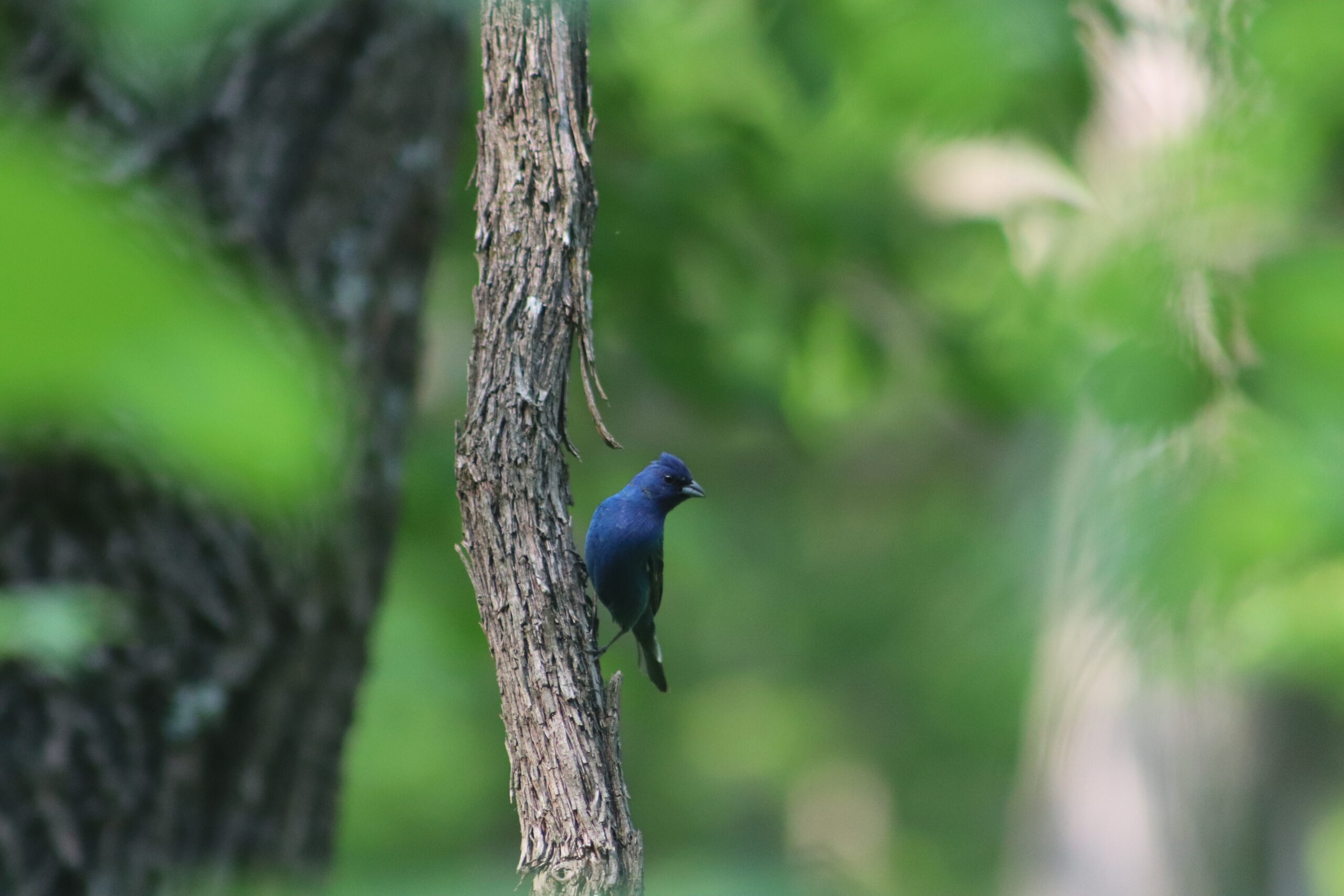An Indigo Bunting perched on a Grapevine (Vitis sp.) in Oldham County, Kentucky. Photo by Jacob Crider
The beautiful and intricate relationships between birds, insects, and their respective host plants
By Jacob Crider, LAS Board of Directors
The well-known Old English proverb, “The early bird gets the worm,” first attributed to William Camden in the 15th century, is often figuratively applied to people—for example, early risers might beat others to the choicest produce at the supermarket. However, its implication that insects such as worms are food sources for all birds actually does not apply to all avians across the board.
In fact, each bird species has a specialized diet based on their preferred habitats and native range. In a healthy and diverse ecosystem, with a sufficient presence of trees, plants, insects, and other animals, there is plenty of food to go around for all.
A plant for all seasons
It can go without saying that plants are entirely pivotal to the life of all animals on Earth. They provide humans with oxygen, a cornucopia of food items—including fruits, leaves, nuts, and roots—shelter, fibers, absorption of carbon dioxide, and many other ecosystem services.
For birds, they offer sites for nesting, roosting, perching, and foraging, and provide habitat for the many prey items that birds favor.
In temperate regions such as Kentucky, the functions that plants provide to birds change by the season. In winter, trees, shrubs, grasses, and wildflowers will produce fruits and seeds for frugivorous (fruit-eating) and granivorous (seed-eating) bird species. Species of insects such as grubs, ants, and insect larvae will inhabit dead or live trees and become food for various woodpecker species, Brown Creepers (Certhia americana), Golden-crowned Kinglets (Regula setrapa).
In spring, early-blooming plant species will begin to attract early waking pollinating species, such as the Spring Beauty Mining Bee (Andrena erigeniae) and the Spring Azure (Celastrina ladon). This time of year usually triggers a shift in feeding habits among our omnivorous birds, which will begin favoring insect prey over the waning supply of winter berries and seeds.
As spring turns to summer, birds have a wide range of diet items to choose from, coinciding with cycles of blooming and leaf- emergence and local insect life-cycles.
The summer is a crucial time for birds for nesting and raising their young. The ability to forage a diet that supports the strongest young and give them the energy to construct and repair a nest is important for birds in temperate regions.
Finally, fall arrives. Plants of the forests, grasslands, and savannas will produce huge seed crops and fruit crops, as well as leave vegetative matter to provide winter habitat and roosting opportunities.
Flies, beetles, and bees all still roam the landscape in search of adequate pollen, rotting logs, or decaying plant matter to use in various ways.
Many butterflies, such as Hackberry Emperors (Asterocampa celtis) and Buckeyes (Junonia coenia), will still have a strong presence in our region—even as the leaves of the Hackberry (Celtis occidentalis), the Hackberry Emperor Host, and the Wild Petunia (Ruelia sp.), the Buckeye Host—begin to fall and decay. Insects will start to crawl into old wingstem (Verbesina) and ironweed stems, and birds will quickly catch on and investigate these situations.
Plants: diverse food sources for birds and host to insect species
Some species of birds—both those occurring year-round and those that are summer migratory birds—are generalists when it comes to feeding on insects, while others are more specialized.
For example, the Bay-breasted Warbler (Setophaga castanea) strongly prefers to visit conifers, where the bird will forage for Spruce Budworms. Yellow-headed Vireos (Vireo flavifrons) nest in diverse deciduous and mixed forests where numerous caterpillar species reside.

An Indigo Bunting (Passerina cyanea)—a dweller of forest edges, open woodlands, and savannas—may prey on many types of insects, and can feed on seeds in the winter. They most likely eat seeds and fruits in Central America, where they overwinter, and turn to insects while nesting and breeding in Kentucky.
Migratory birds encounter an unimaginable number of species of plants and insects along their journeys. Birds with long migratory paths, such as the Yellow Warbler (Setophaga petechia), can encounter plants as far south as Ecuador—palms and kapoks in the winter—and as far north as Alaska—willows and lichens in the summer.
Among the multitude of plants found in Kentucky, some act as a host for more insects than others. Oak trees (Quercus sp.) can host up to 897 species of butterflies and moths (Lepidoptera), and 600 species of wasps and sawflies (Hymenoptera), which together account for more than 1,000 species of insects.
Many animals are dependent on our great oaks. In Louisville, Northern Red Oaks, Chinkapin Oaks, Bur Oaks, and White Oaks are among my favorites, and all are locally occurring in Jefferson County’s natural areas and parks. Hickories, maples, sycamores, and willows also host a wide variety of insects.
Create a bird-friendly yard—and see more birds
Diversity is key when trying to create resourceful and healthy habitats for birds. We can help our native birds in the Louisville area by planting numerous native plants in our yard—which attract and support the life cycles of beneficial insects, provide seeds and fruits for winter birds, and offer breeding bird species habitat for nesting and foraging.
Even planting a few shrubs—such as Elderberry (Sambucus canadensis), Spicebush (Lindera benzoin), or Buttonbush (Cephalanthus occidentalis)—or a single native oak will raise your chances of seeing more bird species in your yard while offering them critical foraging, roosting, and nesting support within urban landscapes.
Native wildflowers and grasses also go a long way toward helping our birds, and likewise are crucial for pollinating insects and lots of other animals. Birds can’t exist without bugs!
Be sure to support local native plant nurseries while designing your landscape or natural-areas project—they may have local ecotypes that your local birds and insects are used to visiting and can guide you toward the right plants.
Good luck seeing all the plant, insect, and bird relationships in Kentucky this summer!

No responses yet